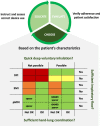How to Choose the Right Inhaler Using a Patient-Centric Approach?
- PMID: 35080761
- PMCID: PMC8790222
- DOI: 10.1007/s12325-021-02034-9
How to Choose the Right Inhaler Using a Patient-Centric Approach?
Abstract
There are many different inhaler devices and medications on the market for the treatment of asthma and chronic obstructive pulmonary disease, with over 230 drug-delivery system combinations available. However, despite the abundance of effective treatment options, the achieved disease control in clinical practice often remains unsatisfactory. In this context, a key determining factor is the match or mismatch of an inhalation device with the characteristics or needs of an individual patient. Indeed, to date, no ideal device exists that fits all patients, and a personalized approach needs to be considered. Several useful choice-guiding algorithms have been developed in the recent years to improve inhaler-patient matching, but a comprehensive tool that translates the multifactorial complexity of inhalation therapy into a user-friendly algorithm is still lacking. To address this, a multidisciplinary expert panel has developed an evidence-based practical treatment tool that allows a straightforward way of choosing the right inhaler for each patient.
Keywords: Asthma; COPD; Dry power inhaler; Inhaler; Patient-centric; Pressurized metered dose inhaler; Treatment algorithm.
© 2022. The Author(s).
Figures

References
-
- Acerbi D, Brambilla G, Kottakis I. Advances in asthma and COPD management: delivering CFC-free inhaled therapy using Modulite technology. Pulm Pharmacol Ther. 2007;20(3):290–303. - PubMed
-
- Barrons R, Pegram A, Borries A. Inhaler device selection: special considerations in elderly patients with chronic obstructive pulmonary disease. Am J Health Syst Pharm. 2011;68(13):1221–1232. - PubMed
-
- Barrons R, Wheeler J, Woods JA. Opportunities for inhaler device selection in elderly patients with asthma or COPD. Patient Intell. 2015;7:53–65.

